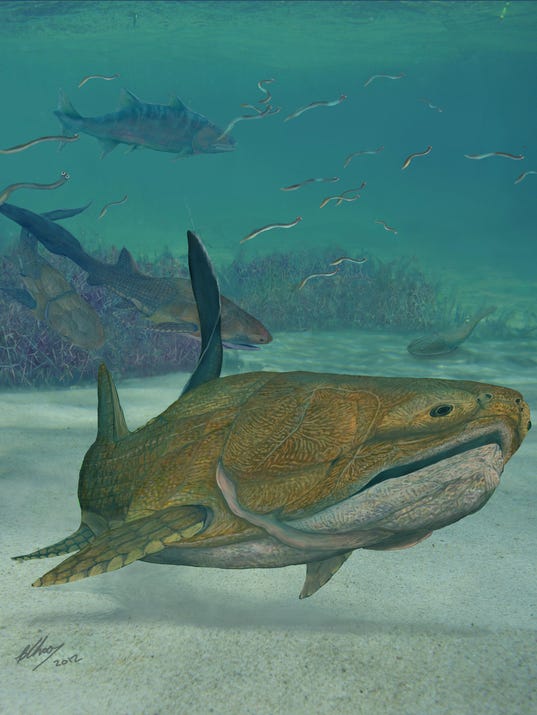This fish is a placoderm, one of a member of an extinct group of gnathostomes (jawed vertebrates), but its jaw is much more like that of a modern bony fish: its discovery may offer a new perspective on the early evolution of these creatures.
The evolution of jaws is one of the key episodes in the evolution of vertebrates, but the gap between jawed and jawless vertebrates is so large that it is hard to work out the individual evolutionary steps in the transition. Min Zhu and colleagues illuminate a step near the end of the process, where modern jawed vertebrates, such as sharks and bony fishes, emerge from a collection of jawed, armored fishes known as placoderms.

Linked from USA Today because the version we received had the head chopped off, which defeats the point. Credit: Brian Choo
Entelognathus primordialis has jaw bone features previously restricted to bony fishes (osteichthyans) as well as full body armor seen in placoderms, and it would have been around 20 cm long. This is the first stem gnathostome with dermal marginal jaw bones (premaxilla, maxilla and dentary), features previously restricted to Osteichthyes.
It was thought that the most recent common ancestor of jawed vertebrates resembled modern sharks, but the new fossil turns this view on its head, according to Matt Friedman and Martin Brazeau. They suggest that the finding provides compelling evidence for the evolutionary link between placoderms and osteichthyans, and adjusts our understanding of early gnathostome evolution.
In USA Today, University of Chicago paleontologist Michael Coates said, "It's important … because it's unexpected. It does present something we had no hint of before."
That's not really true. This is a bombshell because it was absolutely expected. And predicted. It was just a matter of time and luck finding it.
Citation: Min Zhu, Xiaobo Yu, Per Erik Ahlberg, Brian Choo, Jing Lu, Tuo Qiao, Qingming Qu, Wenjin Zhao, Liantao Jia, Henning Blom&You’an Zhu, 'A Silurian placoderm with osteichthyan-like marginal jaw bones', Nature 25 September 2013 doi:10.1038/nature12617





Comments